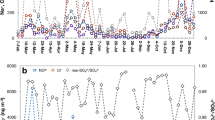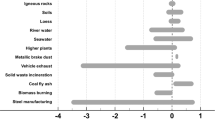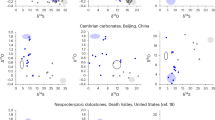Abstract
Since July 1977, the Norwegian Institute for Air Research has been studying trace gases and aerosols in the atmosphere at Bear Island, an Arctic site located at 74° N and 19° E. Although Bear Island lies well north of the Arctic Circle, the warm Norwegian Sea gives it an annual mean temperature of −1.8 °C, considerably warmer than at many other Arctic locations (Barrow, Alaska, for example, is 350 km farther south but has an annual mean of −12.2 °C). In summer, Bear Island is surrounded by open water; in winter there is open sea to the south and west and pack ice to the north and east. Atmospheric samples are taken 20 m above mean sea level and 2 m above local ground: high-volume filters are taken three times a week and analysed for various elements by atomic absorption, neutron activation and wet chemistry; sulphate and sulphur dioxide are measured daily by a method similar to that of Johnson and Atkins1, using low-volume (16 m3) prefilters for sulphate and KOH-impreg-nated afterfilters for SO2. The collection efficiency of this method for SO2 has been tested extensively2. Results for the high-volume samples have been reported3; here we discuss the SO2 data, which seem to indicate that during winter there is efficient transport from Eurasian midlatitudes, due at least in part to long atmospheric residence times in and around the Arctic.
This is a preview of subscription content, access via your institution
Access options
Subscribe to this journal
Receive 51 print issues and online access
$199.00 per year
only $3.90 per issue
Buy this article
- Purchase on Springer Link
- Instant access to full article PDF
Prices may be subject to local taxes which are calculated during checkout
Similar content being viewed by others
References
Johnson, D. A. & Atkins, D. H. F. Atmos. Envir. 9, 825–829 (1975).
Lewin, A. & Zachau-Christiansen, B. Atmos. Envir. 11, 861–862 (1977).
Larssen, S. & Hanssen, J. E. in Pap. at WMO Tech. Conf. on Regional and Global Observation of Atmospheric Pollution Relative to Climate, Boulder (WMO No. 549, Geneva, 1980).
Rahn, K. A. & McCaffrey, R. J. Ann. N. Y. Acad. Sci. 338, 486–503 (1980).
Kerr, R. A. Science 205, 290–293 (1979).
Ottar, B. Atmos. Envir. 12, 445–454 (1978).
Semb, A. Atmos. Envir. 12, 455–460 (1978).
Eliassen, A. Atmos. Envir. 12, 479–487 (1978).
Rodhe, H. Atmos. Envir. 12, 671–680 (1978).
Garland, J. Atmos. Envir. 12, 349–362 (1978).
Prahm, L. P., Torp, U. & Stein, R. M. Tellus 28, 355–372 (1976).
Dovland, H. & Eliassen, A. Atmos. Envir. 10, 783–785 (1976).
Atmos. Envir. 12, 7–23 (1978).
Author information
Authors and Affiliations
Rights and permissions
About this article
Cite this article
Rahn, K., Joranger, E., Semb, A. et al. High winter concentrations of SO2 in the Norwegian Arctic and transport from Eurasia. Nature 287, 824–826 (1980). https://doi.org/10.1038/287824a0
Received:
Accepted:
Issue Date:
DOI: https://doi.org/10.1038/287824a0
This article is cited by
-
Model analysis of the measured concentration of organic gases in the Norwegian Arctic
Journal of Atmospheric Chemistry (1985)
-
Acid snow in the Canadian high Arctic
Nature (1982)
Comments
By submitting a comment you agree to abide by our Terms and Community Guidelines. If you find something abusive or that does not comply with our terms or guidelines please flag it as inappropriate.



